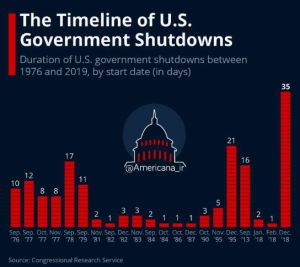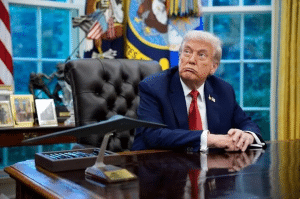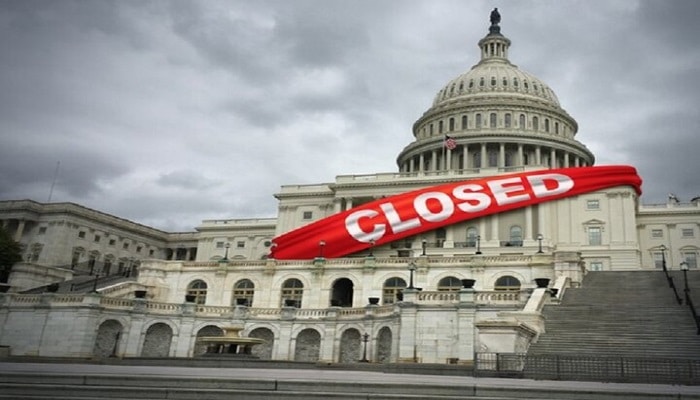PNN – The US government shutdown is approaching the 3-week mark, and if the budget impasse continues, it could break the record for the longest shutdown in history, which was 35 days in 2018.
In the early hours of Wednesday, October 1, 2025, the US federal government entered a widespread shutdown, which has lasted for about 3 weeks to date, after Congress failed to pass a budget bill. This shutdown, which is considered the third longest in American history, is accompanied by the suspension of government services, the forced furlough of hundreds of thousands of federal employees, and widespread disruptions in the functioning of government institutions.
Many observers and officials, including House Speaker Mike Johnson, have warned that this could become the longest shutdown in American history. According to statistics, the record for the longest government shutdown in US history was held by the Bill Clinton administration for many years with 21 days, but in 2018-2019, Trump set a new record with a government shutdown of 35 days, and now it is not far-fetched that this record will be broken in Trump’s second administration.

Causes and roots of the Trump administration shutdown
The current US government shutdown is rooted in various issues, the most important of which are mentioned below:
Political impasse over budget
The current US government shutdown began when the Senate failed to pass two partisan funding bills in consecutive votes. While the House of Representatives passed a temporary funding resolution by a vote of 217 to 212, the Senate was unable to reach an agreement, and the federal government entered a shutdown at midnight on October 1. The main sticking point is Democrats’ insistence on extending the Affordable Care Act’s (ACA) enhanced subsidies, which are set to expire at the end of 2025. The subsidies, which about 22 million Americans use to reduce health insurance costs, would cost about $1.5 trillion to extend over a decade.
Policies to reduce the size of government
Donald Trump, who will be re-elected in January 2025, has taken an aggressive approach to reducing the size of the federal government. He has said in his statements that he will use the government shutdown as an opportunity to cut funding for left-wing projects and shrink the federal bureaucracy. Ross Vote, the director of the White House Office of Management and Budget, is playing a key role in this strategy. He has told Republican lawmakers that the government may begin laying off federal workers during the shutdown. Vote also said that as many as 10,000 people could receive layoff notices. The Trump administration has taken steps in the name of improving government efficiency that critics see as targeted and politically motivated. By August, the Office of Personnel Management had reportedly announced that about 300,000 federal employees would leave the government by the end of the year, 80 percent of whom would be voluntary, but that would mean about 60,000 involuntary layoffs.
What are the domestic and external impacts of a government shutdown?
The government shutdown has had a direct and severe impact on federal employees. According to estimates from the Congressional Budget Office, up to 750,000 government employees have been furloughed and will not receive any pay until a budget is passed. Meanwhile, about 700,000 other essential workers continue to work without pay. A few days ago, federal employees went without pay for the first time, putting a severe financial strain on them and their families.
The government shutdown has disrupted a wide range of public services. Air traffic control has also faced serious problems. The Aerospace Industries Association has warned that the shutdown is disrupting new programs, stifling innovation and slowing down the Federal Aviation Administration. In addition, passport and visa issuance have faced significant delays.
One of the most controversial aspects of the shutdown has been the Trump administration’s decision to cut or suspend funding for infrastructure projects in Democratic-controlled cities. On the first day of the shutdown, the Voice of America reported that about $18 billion in funding for New York City’s infrastructure projects, including the Hudson Tunnel and the Second Street Subway had been suspended. $8 billion has also been cut from climate-related projects in 16 states that voted for Kamala Harris in the 2024 election. In addition, $2.1 billion in funding for Chicago infrastructure projects has also been suspended.
The government shutdown not only has domestic effects but also affects America’s foreign policy and international standing. Amid the crisis, Trump has met with Volodymyr Zelensky at the White House and spoken by phone with Vladimir Putin; these diplomatic moves come at a time when much of the federal government is shut down and State Department employees are on mandatory furlough.

Examining 3 possible scenarios and the future horizon
With nearly three weeks of the US government shutdown, there are several scenarios for the end of this crisis:
First, a bipartisan agreement
The most likely solution is for a bipartisan group of senators to reach a deal that includes temporary funding and some sort of guarantee to discuss the enhanced subsidies of the Affordable Care Act (ACA). However, no significant progress has been made on this issue so far.
Second, the withdrawal of one of the parties
If public pressure or economic consequences become too great, one side might be forced to back down. Given that the Senate has failed 10 times to pass a budget bill, that’s unlikely.
Third, the continuation of the closure
If the impasse continues, the shutdown could approach or even break the record for the longest government shutdown in the United States (35 days in 2018-2019). Overall, the current situation reflects a deep political divide in America that goes beyond budget issues. The shutdown is a symbol of the inability of the two major parties to find common ground and prioritize national interests over partisan interests.
By using the shutdown as leverage to advance its goals of shrinking government, the Trump administration has shown it is willing to pay heavy social and economic costs. Cutting infrastructure projects in Democratic cities, mass layoffs of federal employees, and suspending public services are all part of this strategy.
Democrats, on the other hand, have shown they are unwilling to back down on an issue that affects millions of Americans by insisting on extending the Affordable Care Act’s subsidies. They argue that these subsidies are essential to protecting citizens’ health and cannot be sacrificed for political games.
As a result, this shutdown will have long-term economic, political, social, and international consequences for the United States.
Economically, the longer the lockdown, the greater the impact on economic growth, reduced gross domestic product (GDP) growth, disruption to government services, and a decline in public trust could have lasting consequences.
Politically, this crisis could affect the midterm elections and even the next presidential election. History has shown that the party that is held responsible for a government shutdown usually suffers in the next election.
Socially, pressure on federal employees, disruption of public services, and cuts to social assistance could increase public dissatisfaction and reduce public trust in government institutions.
From an international perspective, the US government shutdown could further reduce the trust of Washington’s allies and encourage rivals to exploit the situation.

